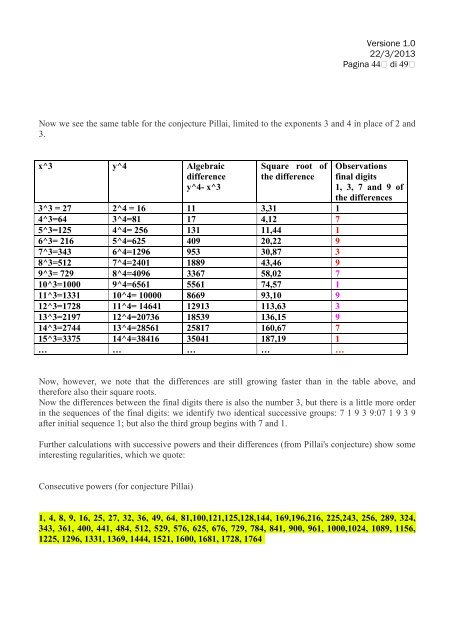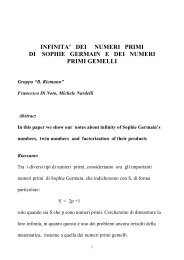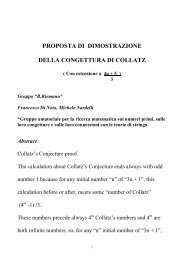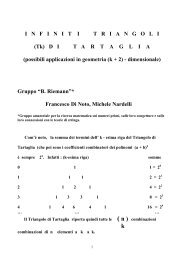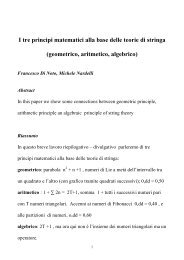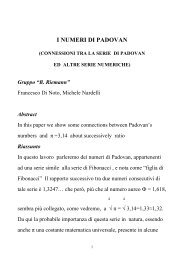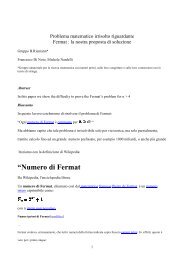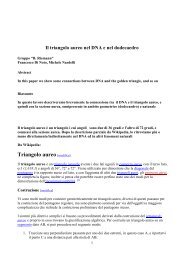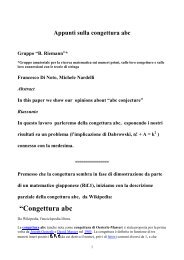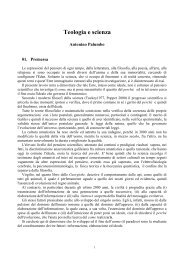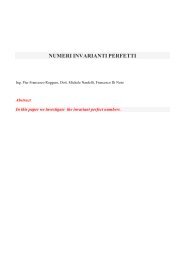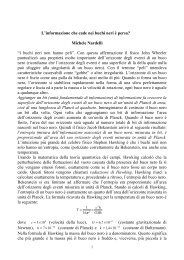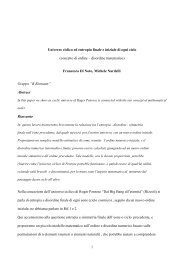proof of fermat-catalan conjecture through the ... - Nardelli - Xoom.it
proof of fermat-catalan conjecture through the ... - Nardelli - Xoom.it
proof of fermat-catalan conjecture through the ... - Nardelli - Xoom.it
Create successful ePaper yourself
Turn your PDF publications into a flip-book with our unique Google optimized e-Paper software.
Versione 1.022/3/2013Pagina 44 di 49Now we see <strong>the</strong> same table for <strong>the</strong> <strong>conjecture</strong> Pillai, lim<strong>it</strong>ed to <strong>the</strong> exponents 3 and 4 in place <strong>of</strong> 2 and3.x^3 y^4 Algebraicdifferencey^4- x^3Square root <strong>of</strong><strong>the</strong> difference3^3 = 27 2^4 = 16 11 3,31 14^3=64 3^4=81 17 4,12 75^3=125 4^4= 256 131 11,44 16^3= 216 5^4=625 409 20,22 97^3=343 6^4=1296 953 30,87 38^3=512 7^4=2401 1889 43,46 99^3= 729 8^4=4096 3367 58,02 710^3=1000 9^4=6561 5561 74,57 111^3=1331 10^4= 10000 8669 93,10 912^3=1728 11^4= 14641 12913 113,63 313^3=2197 12^4=20736 18539 136,15 914^3=2744 13^4=28561 25817 160,67 715^3=3375 14^4=38416 35041 187,19 1… … … … …Observationsfinal dig<strong>it</strong>s1, 3, 7 and 9 <strong>of</strong><strong>the</strong> differencesNow, however, we note that <strong>the</strong> differences are still growing faster than in <strong>the</strong> table above, and<strong>the</strong>refore also <strong>the</strong>ir square roots.Now <strong>the</strong> differences between <strong>the</strong> final dig<strong>it</strong>s <strong>the</strong>re is also <strong>the</strong> number 3, but <strong>the</strong>re is a l<strong>it</strong>tle more orderin <strong>the</strong> sequences <strong>of</strong> <strong>the</strong> final dig<strong>it</strong>s: we identify two identical successive groups: 7 1 9 3 9:07 1 9 3 9after in<strong>it</strong>ial sequence 1; but also <strong>the</strong> third group begins w<strong>it</strong>h 7 and 1.Fur<strong>the</strong>r calculations w<strong>it</strong>h successive powers and <strong>the</strong>ir differences (from Pillai's <strong>conjecture</strong>) show someinteresting regular<strong>it</strong>ies, which we quote:Consecutive powers (for <strong>conjecture</strong> Pillai)1, 4, 8, 9, 16, 25, 27, 32, 36, 49, 64, 81,100,121,125,128,144, 169,196,216, 225,243, 256, 289, 324,343, 361, 400, 441, 484, 512, 529, 576, 625, 676, 729, 784, 841, 900, 961, 1000,1024, 1089, 1156,1225, 1296, 1331, 1369, 1444, 1521, 1600, 1681, 1728, 1764


